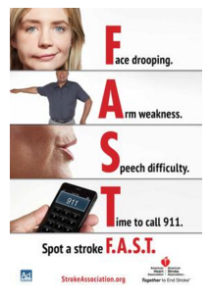STROKE


Background:
A stroke, also known as cerebrovascular accident (CVA), occurs when the blood supply to part of the brain is suddenly interrupted or when a blood vessel in the brain gets damaged causing bleeding in the surrounding brain tissue. Brain cells die when they no longer receive oxygen and nutrients from the blood or there is sudden bleeding into or around the brain. There are two main types of stroke: ischemic, due to lack of blood flow, and hemorrhagic, due to bleeding.
In the United States stroke is a leading cause of disability, and is one of the leading cause of death. Overall, two-thirds of strokes occurred in those over 65 years of age. More than 750,000 people suffer strokes each year in the United States.
Signs and Symptoms:
Stroke symptoms are diverse and vary from one patient to another, but symptoms typically start suddenly, over seconds to minutes, and may progress further. The symptoms depend on the area of the brain affected. The more extensive the area of brain affected, the more functions that are likely to be affected or lost. The symptoms of a stroke include numbness or weakness, especially on one side of the body and face, confusion, trouble speaking or understanding speech, difficulty with vision, loss of balance or coordination, and many others, depending on the areas affected. Although the symptoms of stroke can occur alone, they are more likely to occur in combination. When any of these symptoms occur, 911 must be called.
Diagnosis:
A detailed neurological physical examination, including taking a medical history of the symptoms and a neurological status, helps with evaluation of the location and severity of a stroke. A NIHSS (National Institutes of Health Stroke Scale) standard score is given to grade the severity of the stroke. An emergent non-contrasted CT of the head is obtained in the emergency room, followed by MRI of the brain to evaluate the affected area. Other blood tests and neuroimaging will also be ordered if necessary.
Treatment Options:
Generally, there are three treatment stages for stroke: acute therapy immediately after the stroke, post-stroke rehabilitation and prevention. Recognition that a stroke may have occurred, calling 911, and rapid transport to the appropriate facility are necessary to provide stroke patients with the best chance for acute interventions. Acute stroke therapies try to stop a stroke while it is happening by quickly dissolving the blood clot causing an ischemic stroke or by stopping the bleeding of a hemorrhagic stroke. Thrombolysis, such as with recombinant tissue plasminogen activator (TPA), in acute ischemic stroke, may be beneficial in few selected patients when given at appropriate time, resulting in an overall benefit of 10% with respect to living without disability.
Post-stroke rehabilitation helps individuals overcome disabilities that result from stroke damage. For most people with stroke, physical therapy (PT), occupational therapy (OT) and speech-language pathology (SLP) are crucial during the rehabilitation process. Therapies to prevent a first or recurrent stroke are based on treating an individual’s underlying risk factors for stroke, such as hypertension, atrial fibrillation, and diabetes. Medication or drug therapy is the most common treatment for stroke. The most popular classes of drugs used to prevent or treat stroke are anti-thrombotics (antiplatelet agents and anticoagulants). Smoking cessation, blood pressure control, diabetes control, a low-fat diet, weight control and regular exercise are all also encouraged and recommended.
Prognosis:
The results of stroke vary widely depending on size and location of the affected area. Stroke may cause complications and difficulties with thinking, awareness, attention, learning, judgment, and memory. Stroke survivors often have problems understanding or forming speech. A stroke can also lead to emotional problems as some patients may have difficulty controlling their emotions or may suffer from depression, anxiety, and panic attacks.
Resources:
American Stroke Association
www.strokeassociation.org
Tel: 888-478-7653
National Stroke Association
www.stroke.org
Tel: 303-649-9299
Citations:
NINDS: National Institute of Neurological Disorders and Stroke
URL: http://www.ninds.nih.gov/disorders/stroke/stroke.htm
Accessed November 27, 2015
